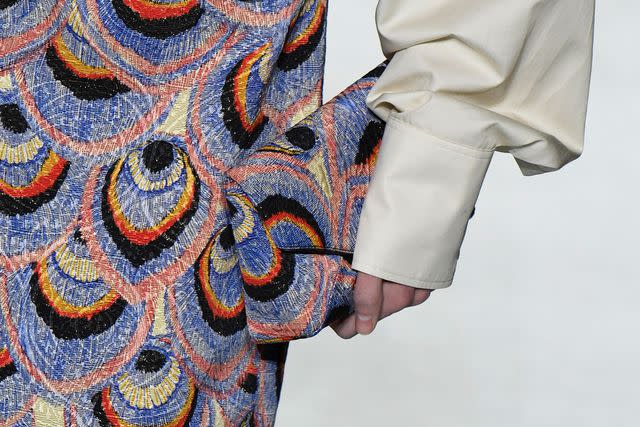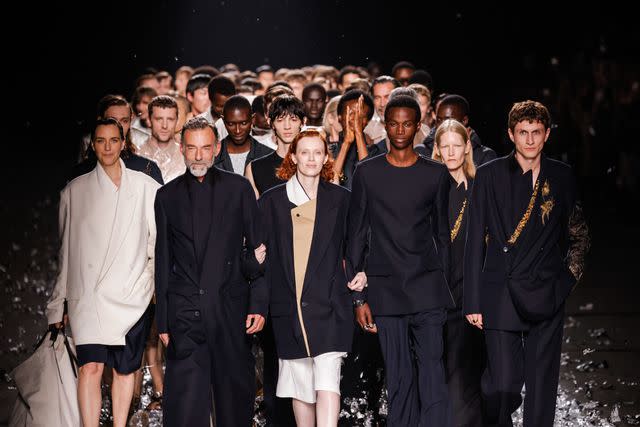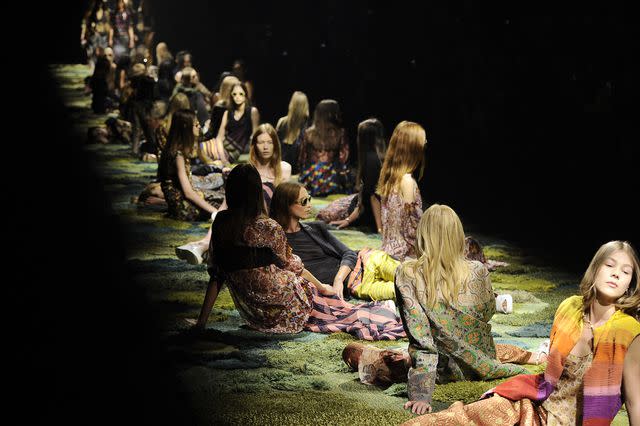Dries Van Noten Knows When to Leave the Party
The Belgian designer's glorious final collection marks the end of an era.

Getty Images
Dries Van Noten shocked the fashion industry in March 2024 when he announced that his upcoming menswear show would be his last. “My dream was to have a voice in fashion. That dream came true,” the Belgian designer wrote in a letter to editors at the time. The curtain was closing on one of fashion’s most exciting and enduring talents at a time when few names are able to stand as firm in their convictions and taste as van Noten has. His dream had become a reality and it was time to go do something else.
With his exit, Van Noten leaves a career that’s nothing short of miraculous: An independent force for more than three decades who forged a path for himself in an industry being rapidly consumed by big conglomerates. A top-notch printmaker and colorist who broke through the noise with not-so-simple clothes made for the everyday person loved by celebrities like Michelle Obama, Nicole Kidman, Margot Robbie, and Cate Blanchett.
Van Noten began his career as a member of the famous “Antwerp Six,” the group of Belgian designers who shifted fashion in the 1980s, which also included Ann Demeulemeester. Since then, his work has focused on finding beauty in the mundane. His love of gardening—a hobby he practices religiously at his home in Antwerp—manifested into decades of floral exploration in his clothing. Color plays a central role in his work, too, fueled by an amalgamation of clashing prints and sumptuous textures. The vibrancy of his printmaking was only eclipsed by the simple perfection of his tailoring, turning a basic Dries Van Noten pant into an “If you know, you know” must-have.

Getty Images
A Dries Van Noten pattern in the designer's 2018/2019 fall/winter collection presented in Paris.Four decades after launching his business, which the Spanish group Puig purchased a majority stake in six years ago, Van Noten seemed at the top of his game, producing both womenswear and menswear, as well as an expanding beauty line. But Van Noten is now 66, a year past the retirement age in his native Belgium. And while the news came as a surprise to his fans, according to The New York Times, he had been thinking about this for years. It was reportedly the reason why he sold a piece of his business in the first place.
As many things go in Van Noten’s universe, the decision to forgo independence for once was all part of an understated and premeditated plan to make sure his line would have an enduring legacy and future without him.

Getty Images
The finale of Dries Van Noten Menswear Spring/Summer 2025 show, the designer's final collection.It was a mature step, and Van Noten's elegant exit solidified his position as one of fashion's most independent thinkers. So much of his career has been unorthodox, so it's fitting that Van Noten’s exit felt more like a revolution than a retirement party.
The designer's final collection, shown this past Saturday during Paris Menswear Week, embodied that ebullient spirit. A confetti-clad runway welcomed guests, and later models walked over the silver material, making it float as they stepped forward. The celebratory mood evolved naturally—from a lineup of signature tailoring in neutral tones of white, navy, and beig to an escalating turn into party mode with gold blazers and Tornasol trench coats. Yet, this was no retrospective, and Van Noten managed to push his work further: clear cargo jackets were paired with snake-printed tops, for example, while trompe l'oeil deconstructed blazers that looked as if they were brush-painted. When Van Noten took his final walk, a massive disco ball served as a backdrop. If there were tears, he did a good job of hiding them.

Getty Images
A look from Dries Van Noten's Menswear Spring/Summer 2025 show at the Babcock factory in La Courneuve as part of Paris Fashion Week.In an industry constantly preoccupied with youth and innovation, retirement is a dirty word. Fashion giants don’t retire—they endure. Karl Lagerfeld held three jobs—creative director at Chanel, Fendi, and his own label—until his death in 2019. Other avant-garde figures like Rei Kawakubo and Yohji Yamamoto, who are both in their 80s, have yet to loosen the reins on their own labels. It’s easy to see why, though: Time and time again, fashion labels struggle to have a creative vision when their founders have retired or passed away, putting successors under the haunting shadow of the brand's creator. Relinquishing control often results in either a disruptive breakaway from the founder's ethos or a constant pressure to live up to their legacy for a successor.
Van Noten knows this. “The last thing I want is that my name becomes just a name that is put on different collections,” he told The New York Times in a recent interview. (Van Noten’s team is producing the upcoming Spring 2025 womenswear collection, but no successor has been announced yet.)

Getty Images
Dries Van Noten takes a bow at his final show at Paris Fashion Week.When Van Noten took his final bow at his Spring 2025 menswear show this Saturday, it was a celebratory moment, a look back at his nearly 40-year career, spanning from his days as a student at the Royal Academy of Fine Arts in Antwerp and first show in London to his 2017 documentary Dries and 100-plus collections since the label’s founding in 1986.
It was also a ripe moment for reflection in a fashion industry plagued by commercialization and corporate conglomerates, where independent designers like Van Noten struggle to even make fashion shows happen, let alone maintain healthy profit margins. For years, young designers have raised the alarm about how much the current system is failing them. London darling Dilara Fındıkoğlu had to pull out of the fashion week calendar last year for fear that it would ruin her business. It’s just one example of how rare success stories like Van Noten’s have become. In losing him, the industry is even more devoid of independent role models.

Getty Images
The finale of Dries Van Noten's Spring Summer 2015 runway show at Paris Fashion Week.One can only hope his legacy will be in good hands with a new designer. Fashion's game of musical chairs with creative directors—brands are always desperate to name names when talent departs—hasn’t drummed up the usual chatter around Van Noten’s successor. Creative consultant Amanda Murray told GQ she hopes it’s someone like the American designer Christopher John Rogers, a fellow devotee of color, while Ssense’s head of content Steff Yokta mentioned Bottega Veneta’s Matthieu Blazy and Undercover’s Jun Takahashi as potential heirs.
Someone recently asked me what I’d want to happen for the brand. “It should just stop,” I replied. The thought of Dries Van Noten without the man himself doesn’t sit right with me. So much of his legacy is wrapped up in who he is: There’s a sensibility in his clothes that can only come from someone who actively chose to forgo the limelight and flashbulbs in favor of garden tending. Someone who studied under Belgian designer Linda Loppa in the 1980s and then forged his own unique path.
But that may just be my grief talking. Whoever takes over, whatever happens, Van Noten's decision to leave on his own terms after decades of excellence sets a new precedent in fashion. Let's hope others follow suit.
For more InStyle news, make sure to sign up for our newsletter!
Read the original article on InStyle.

 Yahoo Lifestyle
Yahoo Lifestyle 
